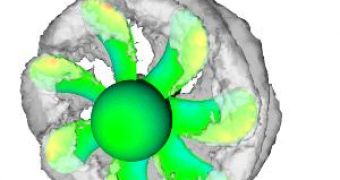Many aircraft, ships or submarines use fluids, like water or air for propulsion, by using propellers to push the fluid backward, which generates forward motion. The propeller is usually attached to the crankshaft of the engine, either directly or through a gearbox.
A new theoretical blueprint aims to replicate this propulsion system on the nanoscale by making tiny machines that pump up fluids with tiny propellers having molecular-sized blades. This idea sounds very good, but actually designing this molecular machinery has proven difficult.
Petr Kr?l, assistant professor of chemistry at the University of Illinois at Chicago and his colleagues have studied realistic conditions in this microscopic environment to learn how the tiny propellers pump liquids.
Other researchers have tried to understand how molecular devices could rotate in flowing gases, but this group focused for the first time on a type of molecular propeller that could pump liquids like oils and water. "We want to see what happens when the propellers get to the scale where it's impossible to reduce the size of the blades any more," said Kr?l.
They discovered that at this molecular scale, the chemical composition of the propeller's blades is very important in determining its efficiency and so is their sensitivity to water. Thus, they showed that the most efficient design would have to use hydrophobic blades, which pump a lot of water by also repelling it.
The efficiency of the blades has been found to rely mainly on their chemical and biological composition, but also on shape and size.
"Pumping rates and efficiencies in the hydrophilic and hydrophobic forms can differ by an order of magnitude, which was not expected," he said. "In principle, we could even attach some biological molecules to the blades and form a propeller that would work only if other molecules bio-compatible with the blades are in the pumped solution."
Although practical applications are still a few years from being completed, given the difficult nature of constructing such ultra-small devices, continuous work on these project could produce significant improvements, meaning that maybe one day nanobots will use this propulsion system in blood vessels in the human body to deliver drugs with unprecedented precision and to examine various organs without any invasive procedures.

 14 DAY TRIAL //
14 DAY TRIAL //